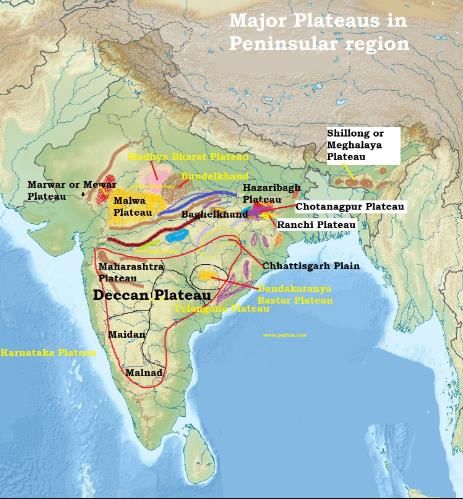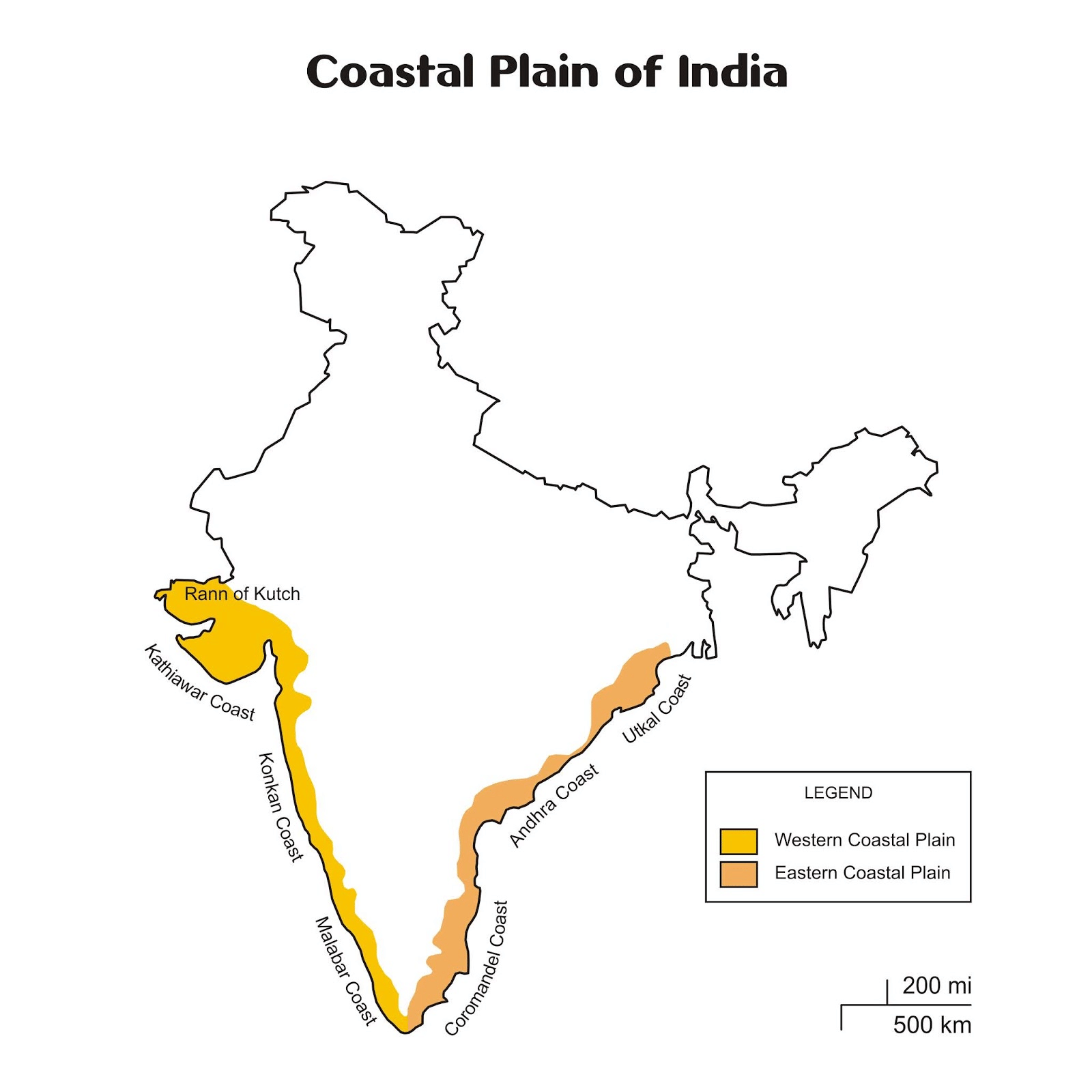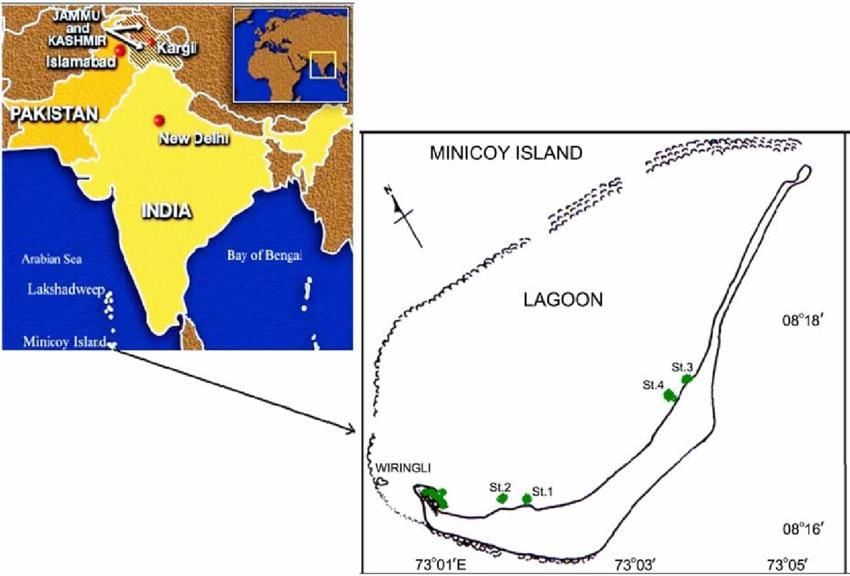NCERT Summary: India - Location - 2 | Geography for UPSC CSE PDF Download
| Table of contents |

|
| The Arunachal Himalayas |

|
| The Northern Plains |

|
| The Peninsular Plateau |

|
| The Indian Desert |

|
| Coastal Plains |

|
| The Islands |

|
The Arunachal Himalayas
- The Arunachal Himalayas extend from the eastern side of the Bhutan Himalayas to the Diphu Pass in the east.
- This mountain range typically runs from southwest to northeast.
- Notable peaks in this region include Kangtu and Namcha Barwa.
 Mountain ranges in Arunachal Pradesh
Mountain ranges in Arunachal Pradesh
- The mountains are intersected by fast-flowing rivers that carve out deep gorges.
- The Brahmaputra River flows through a deep gorge after passing Namcha Barwa.
- Other significant rivers in the area include the Kameng, Subansiri, Dihang, and Lohit rivers, all of which are perennial and have a steep gradient, offering substantial hydroelectric power potential.
 Important rivers of Arunachal Pradesh
Important rivers of Arunachal Pradesh
- A prominent aspect of the Arunachal Himalayas is the presence of various ethnic tribal communities residing in these regions.
- Some of the major tribes, listed from west to east, include the Monpa, Dafla, Abor, Mishmi, Nishi, and Nagas.
- Most of these communities engage in a form of agriculture known as Jhumming, which is also referred to as shifting cultivation or slash-and-burn agriculture.
- The rugged terrain makes transportation between valleys challenging, so interactions are primarily conducted along the duar region bordering Arunachal and Assam.
The Eastern Hills and Mountains
- The Eastern Hills and Mountains are a part of the Himalayan mountain system. These hills stretch from the north to the south.
- They are known by different names in different regions:
In the north, they are called the Patkai Bum, Naga Hills, and Manipur Hills.
In the south, they are known as the Mizo or Lushai Hills. - These hills are relatively low in height and are home to various tribal groups who engage in Jhum cultivation, a traditional form of agriculture.
- The hills are divided by many small rivers. The Barak River is a significant waterway in the states of Manipur and Mizoram.
- Physiography and Water Systems
- Manipur has a distinctive landscape featuring the large Loktak Lake located in the centre of the state, with mountains surrounding it.
- Mizoram, also known as the Molasse Basin, is made up of soft, loosely packed geological deposits.
- Most rivers in Nagaland are tributaries of the Brahmaputra River.
- Two rivers in Mizoram and Manipur are tributaries of the Barak River, which itself is a tributary of the Meghna River.
- Rivers in eastern Manipur flow into the Chindwin River, which is a tributary of the Irrawaddy River in Myanmar.
The Northern Plains
- The Northern Plains of India are a vast and fertile region formed by the alluvial deposits brought by the rivers Indus, Ganga, and Brahmaputra.
- These plains stretch approximately 3,200 km from east to west, with an average width ranging between 150 to 300 km.
- The depth of the alluvial deposits varies between 1,000 to 2,000 meters.
 Indo- Gangetic Plains
Indo- Gangetic Plains
Major Zones of the Northern Plains
- Bhabar: This is a narrow belt, about 8 to 10 km wide, located parallel to the foothills of the Shivalik Range. In this region, streams and rivers deposit heavy materials such as rocks and boulders.
- Tarai: South of the Bhabar zone lies the Tarai belt, which is approximately 10 to 20 km wide. In this area, streams and rivers re-emerge, creating marshy and swampy conditions. The Tarai region is known for its rich diversity of natural vegetation and wildlife.
- Alluvial Plains: Further south, the Northern Plains feature extensive alluvial plains, which can be divided into two sub-regions: Khadar and Bhangar.
- Khadar: This sub-region consists of newer alluvial deposits and is characterized by fertile soil. Khadar land is typically found closer to riverbanks and is subject to regular flooding, which replenishes the soil with nutrients.
- Bhangar: In contrast, Bhangar land is composed of older alluvial deposits and is situated at a higher elevation compared to Khadar land. Bhangar soil is usually less fertile than Khadar soil, but it is still suitable for agriculture.
- The Northern Plains are also home to some of the largest river deltas in the world, including the Sundarbans, which is the largest delta globally.
- This region is generally flat, with an elevation ranging from 50 to 150 meters above sea level.
- The states of Haryana and Delhi act as a water divide between the Indus and Ganga river systems.
- The Brahmaputra River flows from northeast to southwest, making a sharp 90-degree turn at Dhubri before entering Bangladesh.
- The fertile alluvial soil of these river valley plains supports the cultivation of various crops, including wheat, rice, sugarcane, and jute, sustaining a large population.

The Peninsular Plateau
- The peninsular plateau is a triangle-shaped region that rises from about 150 meters above the river plains to an elevation of 600-900 meters. It is surrounded by the Delhi Ridge in the northwest (part of the Aravalis), the Rajmahal Hills in the east, the Gir Range in the west, and the Cardamom Hills in the south. An extension of this plateau, called the Shillong Karbi-Anglong plateau, is found in the northeast.
- This region is made up of several peatland plateaus, including the Hazaribagh, Palamu, Ranchi, Malwa, Coimbatore, and Karnataka plateaus. It is one of the oldest and most stable landmasses in India.
Location of Peninsular Plateau
The general elevation of the plateau increases from west to east, as indicated by river flow patterns. Rivers of the Peninsular Plateau that flow into the Bay of Bengal include the Godavari, Krishna, and Kaveri rivers. Rivers that flow into the Arabian Sea include the Narmada and Tapi rivers. Landforms typical of east-flowing rivers include deltas and floodplains, while west-flowing rivers are known for rift valleys and gorges.
- The Peninsular Plateau is rich in physiographic features such as tors, block mountains, rift valleys, spurs, bare rocky structures, hummocky hills, and wall-like quartzite dykes that create natural water storage areas.
- The western and northwestern sections are characterised by significant black soil. The plateau has undergone various phases of uplift, submergence, crustal faulting, and fracturing, with the Bhima fault being notable for its seismic activity.
- The northwestern part features a complex landscape of ravines and gorges, with the Chambal, Bhind, and Morena ravines being well-known examples.
- Based on relief features, the plateau is divided into three groups: (a) The Deccan Plateau, (b) The Central Highlands, (c) The Northeastern Plateau.

The Deccan Plateau
- The Deccan Plateau is bordered by the Western Ghats in the west, the Eastern Ghats in the east, and the Satpura, Maikal Range, and Mahadeo Hills in the north.
- The Western Ghats, known by various names such as Sahyadri in Maharashtra, Nilgiri Hills in Karnataka and Tamil Nadu, and Anaimalai Hills and Cardamom Hills in Kerala, are generally higher and more continuous than the Eastern Ghats, averaging about 1,500 m in elevation, increasing from north to south. The highest peak in the Western Ghats is Anamudi at 2,695 m, followed by Doddabetta at 2,670 m. Most peninsular rivers originate in the Western Ghats.
- The Eastern Ghats, made up of discontinuous and low hills, have been significantly eroded by rivers like the Mahanadi, Godavari, Krishna, and Kaveri. Notable ranges include the Javadi Hills, Palconda Range, Nallamala Hills, and Mahendragiri Hills. The Eastern and Western Ghats meet at the Nilgiri Hills.
 Deccan Plateau
Deccan Plateau
The Central Highlands
- The region is bounded to the west by the Aravali Range. The Satpura Range consists of a series of scarped plateaus in the south, typically at an elevation of 600-900 m above sea level. This range forms the northern boundary of the Deccan plateau and is a classic example of highly eroded relict mountains that create discontinuous ranges.
- The extension of the peninsular plateau reaches as far as Jaisalmer in the west, where it is covered by longitudinal sand ridges and crescent-shaped sand dunes called barchans. This area has undergone metamorphic changes in its geological history, evident from the presence of rocks like marble, slate, and gneiss.
- The general elevation of the Central Highlands varies between 700-1,000 m above mean sea level, sloping towards the north and northeast. Most tributaries of the Yamuna River originate in the Vindhyan and Kaimur ranges.
- The Banas is the only significant tributary of the Chambal River that comes from the Aravalli in the west. The eastern extension of the Central Highlands is represented by the Rajmahal Hills, south of which is a large reserve of mineral resources in the Chotanagpur plateau.
 Central Highlands
Central Highlands
The Northeastern Plateau
- This area is an extension of the main peninsular plateau. It is thought that the northeast movement of the Indian plate during the formation of the Himalayas created a large fault between the Rajmahal Hills and the Meghalaya plateau. Over time, this depression was filled by the sediments from various rivers.
- Today, the Meghalaya and Karbi Anglong plateaus are separate from the main peninsular block. The Meghalaya plateau is divided into three hills: (i) The Garo Hills, (ii) The Khasi Hills, and (iii) The Jaintia Hills. These hills are named after the tribal communities living in the area. The Karbi Anglong hills of Assam are also an extension of this plateau. Like the Chotanagpur plateau, the Meghalaya plateau is rich in mineral resources such as coal, iron ore, sillimanite, limestone, and uranium.
- This region receives a lot of rainfall from the southwest monsoon, resulting in a highly eroded surface. Cherrapunji shows a rocky landscape with little permanent vegetation cover.
 Banas-Tributary of Chambal River
Banas-Tributary of Chambal River
The Indian Desert
- Location: The Great Indian Desert is situated to the northwest of the Aravali hills.
- Landscape: The desert features a terrain of rolling hills, extensive sand dunes, and barchans (crescent-shaped sand dunes).
- Climate: This region experiences very low annual rainfall, less than 150 mm, resulting in an arid climate with sparse vegetation. These conditions have led to its nickname, Marusthali.
- Geological History: During the Mesozoic era, this area was likely covered by water. Evidence for this includes the discovery of wood fossils in Aakal Park and ancient marine deposits near Brahmsar, close to Jaisalmer. The wood fossils are estimated to be around 180 million years old. While the underlying rock is part of the peninsular plateau, the surface has been shaped by physical weathering and wind over time.

Key Landforms
- Mushroom Rocks: Unique rock formations shaped by erosion.
- Shifting Dunes: Sand dunes that move due to wind activity.
- Oases: Water-rich areas, primarily found in the southern part of the desert.
- Division by Slope:The desert is divided into two parts based on slope:
1. Northern Part: Slopes towards Sindh.
2. Southern Part: Slopes towards the Rann of Kachchh. - Rivers: Most rivers in this region are ephemeral, meaning they only flow for part of the year. The Luni River, located in the southern desert, is a significant waterway.
- Water Deficit: The region faces a water deficit due to low rainfall and high evaporation rates. Some streams disappear after a short distance, typical of inland drainage, leading to lakes or playas.
- Salt Sources: Lakes and playas in the desert contain brackish water, which is the primary source of salt in the region.
Coastal Plains
India's extensive coastline forms one of the most distinguishing features of its geographical landscape, stretching across thousands of kilometers and framing the Indian peninsula. The coastal plains of India are divided into two distinct regions based on their geographic location and the active geomorphological processes that shape them: the Western Coastal Plains and the Eastern Coastal Plains. Each of these regions exhibits unique characteristics that influence the climate, biodiversity, and human settlements along their respective coasts, making them vital areas of study in Indian geography
Western Coastal Plains
- The western coastal plains are a type of submerged coastal plain. The ancient city of Dwaraka, once part of the Indian mainland, is now underwater.
- This submergence results in a narrow belt that is ideal for the development of ports and harbours.
- Important natural ports on the west coast include Kandla, Mazagaon, JLN Port Navha Sheva, Marmagao, Mangalore, and Cochin.
- The western coast stretches from the Gujarat coast in the north to the Kerala coast in the south and is divided into regions such as the Kachchh and Kathiawar coast in Gujarat, the Konkan coast in Maharashtra, the Goa coast, and the Malabar coast in Karnataka and Kerala.
- The western coastal plains are narrower in the middle and wider towards the north and south.
- Rivers in this coastal plain do not create deltas.
- The Malabar coast features unique Kayals (backwaters) that are used for fishing and inland navigation, attracting many tourists.
- Every year, the famous Nehru Trophy Vallamkali (boat race) takes place in Punnamada Kayal, Kerala.
Eastern Coastal Plains
- In contrast, the eastern coastal plain is broader and is an example of an emergent coast.
- This area has well-developed deltas formed by rivers that flow eastward into the Bay of Bengal, including the Mahanadi, Godavari, Krishna, and Kaveri deltas.
- Due to its emergent nature, the eastern coastal plain has fewer ports and harbours compared to the western coast.
- The continental shelf extends up to 500 km into the sea, making it challenging to develop good ports and harbours.
The Islands
India's diverse island territories, such as the Andaman and Nicobar Islands in the Bay of Bengal and the Lakshadweep and Minicoy Islands in the Arabian Sea, are critical components of its geographical identity. These islands, varying in their geological make-up and ecological profiles, are distributed strategically along key maritime routes. The Andaman and Nicobar Islands, with their volcanic origins and complex underwater mountain systems, contrast with the coral formations of the Lakshadweep and Minicoy Islands. Each group of islands plays a crucial role in India’s maritime security, environmental conservation, and supports unique biodiversity, thereby being essential subjects of study in Indian geography. Islands in India
Islands in India
Andaman and Nicobar Islands
Located in the Bay of Bengal, this group is composed of around 572 islands situated between 6ºN – 14ºN latitude and 92ºE-94ºE longitude. The Andaman Islands are in the north, and the Nicobar Islands are in the south, separated by the Ten-degree Channel. These islands are believed to be parts of underwater mountains, with some of volcanic origin. Notably, there is a barren island in the Nicobar group that houses India’s only active volcano.
Lakshadweep and Minicoy Islands
Located in the Arabian Sea, these islands are located between 8ºN latitude and 71ºE-74ºE longitude, approximately 280 km-480 km off the Kerala coast. The entire group consists of coral deposits, comprising around 36 islands, with 11 of them inhabited. Minicoy is the largest island in this group, covering an area of 453 sq. km. The Eleventh-degree Channel divides the islands into northern and southern parts, with Amini Island to the north and Kannur Island to the south. The eastern shore of these islands features storm beaches made up of pebbles, shingles, cobbles, and boulders.
 Lakshadweep and Minicoy islands
Lakshadweep and Minicoy islands
|
175 videos|624 docs|192 tests
|
FAQs on NCERT Summary: India - Location - 2 - Geography for UPSC CSE
| 1. What are the major geographical features of India as mentioned in the article? |  |
| 2. How do the Arunachal Himalayas influence the climate of India? |  |
| 3. What is the significance of the Northern Plains in India? |  |
| 4. What are the key characteristics of the Peninsular Plateau? |  |
| 5. How do the Coastal Plains and Islands contribute to India's geography? |  |
















